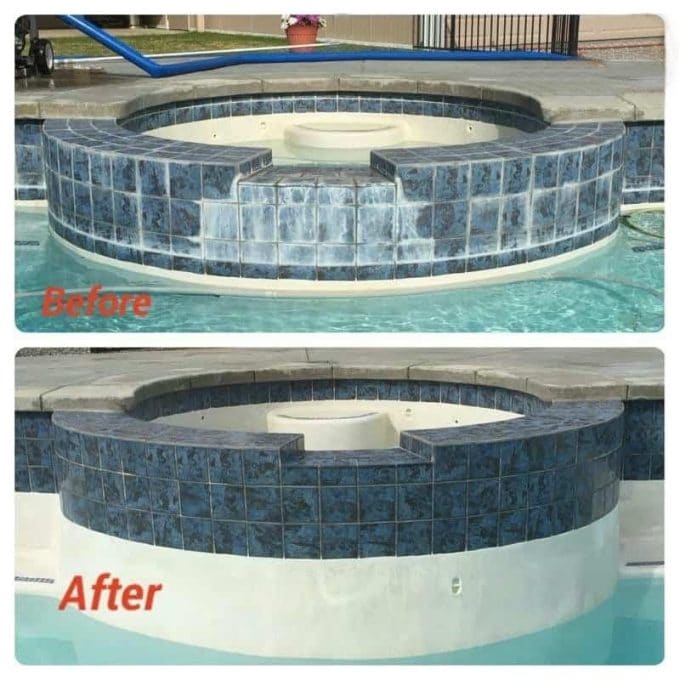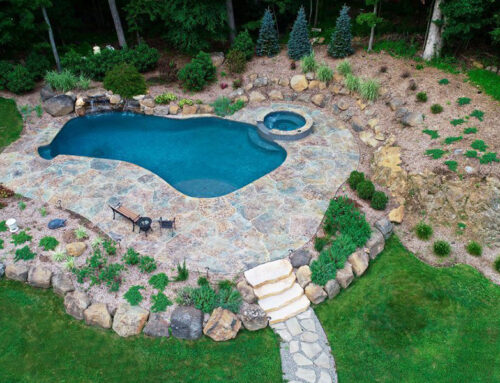
We always emphasize the importance of regular swimming pool servicing visits to assure that your water is healthy and the proper pH, which is 7.4 to 7.6—the same pH of your tears. When water chemistry is balanced, you can prevent a lot of repair headaches since water quality impacts the pool filter, pool pump, swimming pool heater and other mechanical’s, along with the gunite pool plaster or vinyl pool liners, and pool tile.
Technical stuff aside, when pool tile is sparking clean it looks fantastic! When there’s buildup on the pool tile, not so much. Whether the impetus for cleaning your pool tile is to polish it up for a party or make it glisten for your own enjoyment, there are some basic steps to follow so you can get the best results.
Here are some pool tile cleaning tips and recommendations from the certified pool technicians at our swimming pool company.
Lower the Water Level to Clean Tile
Drain the pool so the water is just below the pool tile line. This will allow you to properly brush, scrub or apply a cleaning treatment to the tile. By exposing the tile, you’ll have an easier time accessing the tile without splashing water all over the place.
Always Test Your Cleaning Tool
Whether you use a nylon or stainless-steel brush, or pumice stone, test the tool on a tile first. Examine the results to be sure there is no damage. While the cleaning brushes and tools we recommend are safe for all types of pool tile, you can never be too careful. If you have to scrub too hard to remove buildup, then your pool tile likely needs a more concentrated solution and professional pool cleaning.
Brush Away Algae
If algae is the issue, try a nylon brush and work in a circular motion to loosen algae from the pool tile. If the algae is particularly stubborn, try spraying tile with vinegar and allowing it to sit before brushing away the scum.
Use Pumice to Remove Calcium Deposits
A pumice stone is a convenient, inexpensive pool tool to keep on hand—and it’s especially helpful for removing calcium deposits from pool tile. Pumice is good for removing calcium, lime, stains and algae. (You can use a nylon brush for algae, but pumice works, too.) Pumice compared to stainless steel brushes that can be more abrasive, is all-natural, gentle on tile and effective at “exfoliating” buildup from surfaces. Be sure to wet the pumice stone and tile before using it in a back-and-forth motion.
Mix Muriatic Acid and Water
If vinegar and a pumice stone or brush are not enough to remove challenging stains or residue, then a muriatic acid-water mixture can help. Take care when using muriatic acid—it’s safe but requires some care when mixing and applying it to tile. Wear protective eyewear and gloves. In a bucket, mix 1 part muriatic acid to 4 parts water. Use a pool brush and scrub tile using the mixture.
Call in the Pros
If your pool tile has been neglected, consider a professional pool cleaning visit to get it back into shape—then you can more easily maintain your tile with a simple brush or pumice stone. Because water chemistry is the main reason that pool tile collects algae, calcium, lime and stains, commit to checking your pool’s water chemistry on a weekly basis.
Contact us for pool maintenance and our team of certified pool technicians will help you preserve your investment and prevent costly repairs. Call 845-463-0592 in Hudson Valley, 914-271-7996 in Westchester and 203-212-4800 in Connecticut. Or, fill out this convenient contact form and we’ll get in touch with you.
























